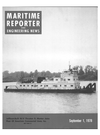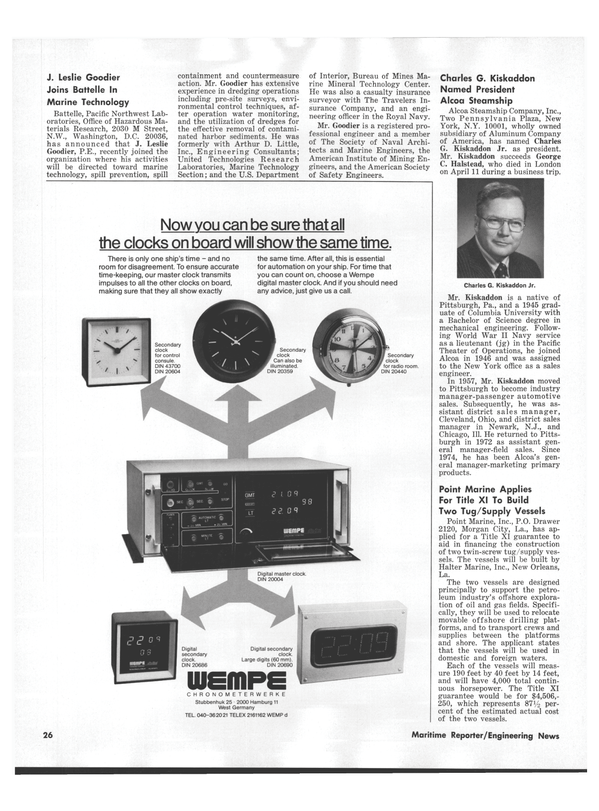
'Ocean Trade And Transport Of Phosphate Rock7
In common with most other bulk commodities, the seaborne trade of phosphate rock has been adversely affected by the prolonged world economic depression which followed the "oil crisis" of 1973.
This was most apparent in 1975 and 1976, when shipments fell to 26 percent below the peak level of 50 million tons attained in 1974.
During 1977, however, there was a marked improvement in the state of the phosphate rock market, and seaborne shipments rose to total 44.1 million tons. This was a 19 percent increase over the level recorded in 1976. The object of "Ocean Trade and Transport of Phosphate Rock"—No. 65 in a series prepared by H.P.
Drewry (Shipping Consultants) Limited — is to review both the development of trade as a whole and the future pattern of phosphate shipments within the regional markets, as well as the ocean transportation of phosphate rock.
The recent upward trend in the level of phosphate rock shipments is expected to continue. In fact, it is estimated, based on regional imbalances in phosphate supply/ demand and the knowledge of intra-area exchanges, that world seaborne trade in phosphate rock will increase to some 58 million tons by 1980, and 72 million tons by 1985. However, despite the forecast increase in the volume of trade, the actual pattern of trade is not expected to alter significantly over the next eight years.
The consumption of phosphate is heavily concentrated in the developed countries, with over half being consumed in Europe and some 20 percent in North America, and it is, therefore, these areas that dominate phosphate rock demand. Demand in Europe is expected to increase by almost 50 percent by 1985, with Eastern European demand increasing the most to total over 40 million tons.
Very substantial growth is forecast for Asian countries and is projected to rise by 80 percent to reach over 24.0 million tons by 1985. North American demand is expected to increase slowly due to the already advanced agricultural techniques, low population growth, etc. Latin America and Africa at present constitute a relatively small market for phosphate rock, but the greatest proportional increases in demand are forecast for these areas.
World demand f o r phosphate rock is expected to rise to around 130 million tons by 1980, and will have reached almost 160 million tons by 1985.
Practically all phosphate rock now entering seaborne trade is shipped loose in bulk, and because of its handling characteristics can be shipped in virtually any type or size of bulk carrier.
However, the relatively short shipping distances involved in phosphate rock trades, combined with the draft limitations and the general lack of suitable storage capacities and inadequate handling facilities associated with ports where phosphate rock is loaded or discharged, have meant that the vessels employed in the phosphate rock trade are predominantly g e n e r a l - p u r p o s e, geared vessels of between 25,000 dwt and 50,000 dwt. The wide distribution of the world phosphate rock trade among ports which are poorly equipped or have too small a throughput to encourage improvements, is the principal reason why the smaller ship sizes are expected to retain an important although diminishing share of this trade through to 1985. The expectation is that bulk carriers of between 20,000 dwt and 50,000 dwt will be employed far more extensively than the larger ships. The share of total trade attributed to vessels below 20,000 dwt will be reduced to less than a third by 1985 as a result of their gradual replacement by larger bulk carriers.
As well as reviewing the development of trade and the future pattern of phosphate shipments, "Ocean Trade and Transport of Phosphate Rock" examines the present pattern of trade on a regional basis and interarea matrices of seaborne trades are presented for the years 1975- 77. The supply of phosphate rock is examined by means of a country-by-country review which provides an insight into expansion plans. Particular emphasis is placed on the ocean transportation of phosphate rock, and separate sections have been devoted to the types and sizes of ship employed, transport costs and ports handling this fertilizer raw material. An appendix which lists phosphate rock loading ports, with information on draft limits, etc., is also provided.
"Ocean Trade and Transport of Phosphate Rock," No. 65 in a series of reports on various aspects of shipping prepared by the Research Division of HPD Shipping Publications, 34 Brook Street, Mayfair, London W1Y 2LL, England, is available at a single copy rate of U.S. $85 (all overseas orders) or £35 (U.K. only), or on a subscription basis U.S. $325 (all overseas orders), or £135 (U.K.
only) for the series 61-70.
Read 'Ocean Trade And Transport Of Phosphate Rock7 in Pdf, Flash or Html5 edition of September 1978 Maritime Reporter
Other stories from September 1978 issue
Content
- Marine Engineering Firm Formed In Oregon page: 4
- Jurong Shipyard Ltd. Awarded Multimillion Conversion Contract page: 4
- Data Sheet Describes Shipboard Interior Fireproof Panels page: 4
- Jeffboat Delivers The Thruston B. Morton page: 6
- Bell Aerospace Delivers 160-Ton Air Cushion Landing Craft To Navy page: 6
- Avondale To Construct Two Multi-Product Ships For Ogden Marine page: 6
- Orion Gautreaux Named Zapata Vice President page: 6
- Rhine-Schelde-Verolme And IHC Offshore Yard Effect Shipbuilding Merger page: 7
- APL To Build Five New Containerships page: 8
- Kongsberg Systems, Inc. Names Ambjor President page: 8
- Eagle Dredging Awards $25-Million Contract To Avondale Shipyards, Inc. page: 8
- Newfoundland Headed For Major Economic Advances In 1980s page: 9
- Tracor Marine Awarded $3.6-Million Navy Contract page: 10
- Sheridan Lee Opens New York Office page: 10
- ALRC Gets $13-Million Award To Supply Pumps For Boeing-Built Ships page: 10
- W.E. Christiansen Jr. Joins St. Louis Ship page: 10
- PSI Completes Total Package Concept With Todd 'Apache' Contract page: 12
- Third Generation Ro/Ro Subject Of New York SNAME Section Meeting page: 14
- John Smith Named Yard Operations Director At NASSCO page: 14
- MarAd Study Examines Shipping Policy Options page: 14
- Three-Day Maritime Safety Meeting Set For Chicago October 2-4 page: 15
- Cargo Security Study Sponsored By Government page: 16
- Todd Pacific Shipyards Launches Guided Missile Frigate Wadsworth (FFG-9) page: 16
- J. Ray McDermott & Co., Inc. Delivers 126-Foot Tug To Louisiana Tugs Company page: 16
- First Crab Boat Built By Halter Marine, The 150-Foot Alaskan Enterprise, To Operate In Bering Sea For Francis Miller page: 16
- Agri-Trans Names Miller Director Gulf Operations page: 17
- Robert Hague Post Honors James A. Farrell Jr. page: 18
- Boeing Awards Six Hydrofoil Contracts Totaling $4,360,000 page: 18
- Hongkong United Dockyards Ltd. (HUD) Forms New Subsidiary page: 18
- NKK Signs Agreement With Baker Marine Corp. page: 20
- Women Invade Engineers' Seagoing Dredge Fleet page: 20
- Uniflite Awarded $3.2-Million Navy Contracts For Target Boats page: 22
- Technical Report On Mooring For LNG Ships Released By MarAd page: 22
- Port Electric Named Marine Distributor By Jeamar Winches Ltd. page: 22
- Perry Oceanographies Designs And Builds New Undersea Work System page: 23
- 'Ocean Trade And Transport Of Phosphate Rock7 page: 24
- Samson And SMATCO Join To Expand Traction Winch Market page: 24
- Captain Tom Smith Forms CTS And Associates page: 24
- Charles Lehman Elected ACBL Vice President page: 24
- Swann Oil Relocates New York Office page: 24
- IMODCO Receives Third Contract From PEMEX In Two-Month Period page: 24
- Salen & Wicander Opens Office In United States page: 25
- Zapata Corporation Announces Senior Management Promotions page: 25
- J. Leslie Goodier Joins Battelle In Marine Technology page: 26
- Charles G. Kiskaddon Named President Alcoa Steamship page: 26
- James H. Sanborn Joins Interstate And Ocean Transport Company page: 26
- John J. McCarthy Joins Waukesha Engine Div. Dresser Industries, Inc. page: 27
- lotron Corporation Introduces Automatic RPM/Speed Converter page: 27
- Peoples' Republic Of China Concentrates On Building Up Bulk Carrier Fleet page: 28
- L. James Gardner Joins Bath Iron page: 29
- Castle & Cooke, Inc. Plans Purchase Of Seven Ships page: 29
- Halter Marine Announces Corporate Name Change page: 30
- Dravo SteelShip Names Frank C.A. van Bentem 30 Maritime Reporter/Engineering News Engineering Director page: 30
- Nominations Are Open For Shepheard Award For Maritime Safety page: 30
- Human Element In Ship Operation Is Subject Of Maine Maritime Seminar page: 30
- Halter Marine Adds Tenth Shipyard page: 30
- API Annual Tanker Conference To Be Held At Tarpon Springs Oct. 1-4 page: 32
- Paceco International Appoints Alan Holme Managing Director page: 32
- Cuba Takes Delivery Of Third Canadian-Built Ship page: 34
- Smit Nymegen Corporation Holds Seminars On Independently Fired Inert Gas Generators page: 34
- Raymond Subsidiary Awarded $10-Million Contract In Venezuela page: 36
- Port Everglades Foreign Trade Zone Expansion Approved page: 36
- Canadian Shipbuilding Production Summary For First Six Months page: 36
- Gulf Mississippi Adds Two Vessels To Fleet For Offshore Service page: 38
- Lennart Thorell Joins Todd Pacific Shipyards page: 38
- Marine Concrete Structures Delivers First 2 Platforms From New Dock Facility page: 38
- Halter Marine Delivers First Of Three Supply Boats To Brazil —First From U.S. Shipbuilder page: 40
- The 1,000-Foot M/V George A. Stinson Joins National Steel's Fleet Of Ore-Carrying Vessels page: 40
- Australian Designs Fast 1,600-Ton Containership With Crew Of Only Five page: 40
- Davie Shipbuilding Buys Branch Lines, Operator Of Tankers page: 42
- Michael Kenney Named President Of Jacksonville Propeller Club page: 42
- SNAME Gulf Central Section Told How A Load Line Assignment Is Obtained page: 43
- Repairing Vessels Since 1834, Camden Ship Repair Company Starts $4-Million Expansion page: 44
- API President Suggests That Oil Firms Should Participate In Solving U.S. Energy Dilemma page: 44
- ITT Decca Marine Forms New Marketing Services Department page: 45
- $4.5-Million Loan For Northern Metals Marine Terminal page: 46
- Robert Ivey Joins Mississippi Marine Towboat Corporation page: 46
- World And U.S. Bulk Shipping page: 46
- Bay Shipbuilding Delivers Bulk Carrier M / V Buffalo To American Steamship Company page: 47
- Navy Awards IMODCO Development Contract For Portable SPM page: 48
- Waukesha Engine Names Donald E. Bates To Sales Post in Kuwait page: 49
- APL Names Kenneth Passe Mgr. Offshore Operations page: 49
- The Effect Of The 1978 IMCO Tanker Safety And Pollution Prevention Conference On Ship Design And Operation page: 49
- James Sweat Joins Matzer Associates page: 49
- Offshore Logistics, Inc. Announces Earnings For The Year Ended June 30 page: 49
- Tokyo Marine Services Starts Trans-Pacific Drydock Tow page: 50
- Quaker Chemical Corporation Acquires Selby, Battersby— David Kollock Named President page: 50
- Maritime Transportation Research Board Names Five New Members page: 50
- Francis A. Martin And Ottaway, Inc. Name Norman Jensen Partner page: 50
- Francis W. Bauer Joins ORBA Corporation page: 51
- Largest Vertical Submerged Screw Pumps Successfully Tested At Delaval Turbine page: 52
- Jardine Plans To Restructure Oilfield Servicing—New Name Jardine Offshore Promet page: 52
- Sea-3, Inc. Names Two New Vice Presidents page: 53
- California SNAME Sections Announce Joint Meeting page: 56
- Offshore Floatel To Accommodate 600 Workers page: 58
- Biehl & Company Opens Tenth Office In Atlanta, Georgia page: 58
- Acadian Supply Files Amended Application For Towing Vessels page: 59
- Port Everglades Propeller Club Installs Officers page: 59
- Italian Government Honors Worthington Pump Chief Executive page: 60
- Overseas Shipholding Group Reports Increased Earnings page: 60
- MARCO 'Modularizes' U.S. Navy Oil-Spill Skimmers For Easy Transport By Aircraft And Truck page: 61


